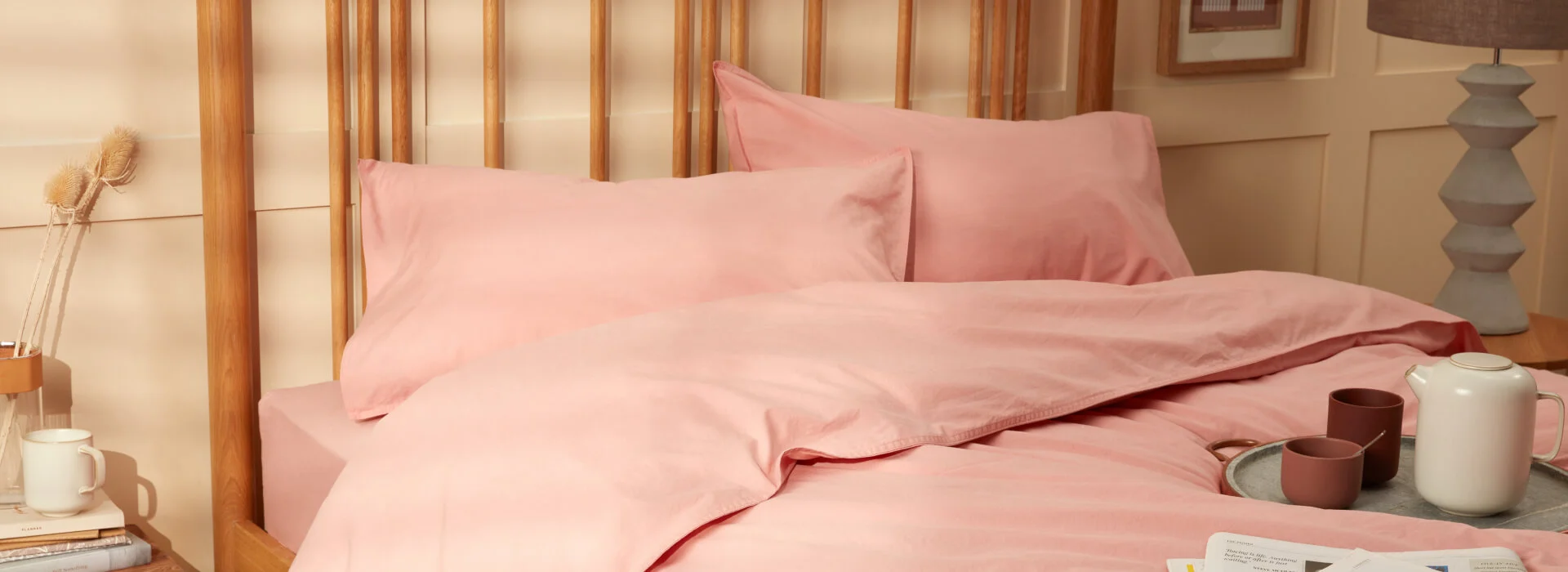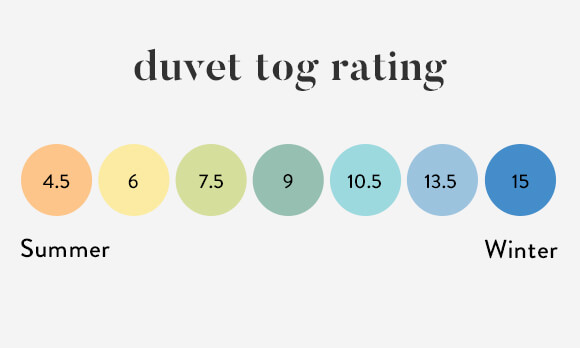
Quick Links
Sizes & Measurements Thread Counts & Fabric Qualities Togs Choosing the Right Duvet & Pillow Mattress & Pillow Protectors Caring for Your Bedding Recommended Bedding Brands
Sizes & Measurements
Bedding Sizes
UK Standard Duvet Covers
- Single - 200 x 135cm
- Double - 200 x 200cm
- King - 225 x 220cm
- Super King - 260 x 220cm
China Standard Duvet Covers
- Single - 200 x 150cm
- Double - 215 x 180cm
- King - 230 x 200cm
- Super King - 240 x 220cm
Fitted Sheets
UK Standard Fitted Sheets
- Single - 190 x 90cm
- Double - 190 x 135cm
- King - 200 x 150cm
- Super King - 200 x 180cm
Standard sheets are usually up to 26cm deep.
China Standard Fitted Sheets
- Single - 200 x 100cm
- Double - 200 x 120cm
- King - 200 x 150cm
- Super King - 200 x 180cm
Pillow Cases
UK Standard Pillow Cases
- Standard Pillow Cases - 75 x 50cm
- Oxford Pillow Cases - 75 x 50cm (with a 5cm flap of material around the outside)
Thread Counts & Fabric Qualities
What Does Thread Count Mean?
Essentially, thread count refers to the number of threads per inch of fabric; the density of the threads per inch. The general rule is that the higher the thread count the higher the quality of fabric and the smoother the fabric is to touch.
Shop our bedding collection here >
Plain & Printed Cotton
Plain bedding can be looked at like a blank canvas. It brings with it, the opportunity to decorate, mix and match pillows and throws, or keep to a minimalist look.
Printed, on the other hand, is an easier way to energise your room. If you’re not completely au fait with home decoration, opt for a printed bedding set which will do all the decorating for you.
Shop our bedding collection here >
What is percale / percale cotton?
Percale is a type of weaving process which takes one thread over the other so that both sides of the fabric are the exact same. When percale weaving is produced with 100% cotton, it produces a classic matte crisp finish to the fabric, creating a soft feel. The tight weaving process with combed cotton yarn enables an elegant and smooth feel that makes the bedding durable for everyday use.
What is Sateen fabric?
As opposed to percale which gives a crisper finish, sateen weaving process leaves the fabric feeling silky and smooth. Specifically designed to give the fabric a soft touch, when 100% is weaved sateen-style, the bedding is given a breathable element, making it a great fabric for snuggling up in bed.
What is Waffle bedding?
Waffle bedding is made from micro waffled-textured cotton, usually on one side of the fabric and smooth on the reverse. Usually soft to touch, waffle bedding is a great way to add texture to your room.

A Guide to Togs
What is a Tog?
Togs, in its simplest form, refers to the thermal resistance and warmth of a duvet. Essentially the higher the tog the warmer the duvet will be.
How to choose the right tog rating for you
This will depend on the individual’s preferences and needs including warmth of the home, climate of the location, personal preference of temperature at night and body metabolism. For less warmth, request a lower tog rating, and for more warmth retention, choose a higher tog rating.
Choosing the Right Duvet & Pillow
Feather and Down Duvets
Feather and down duvets, or otherwise known as naturally filled bedding, offer warmth, durability and weight to your sleep. Commonly sought after as a worthwhile investment, feather and down duvets provide long-lasting use and increase insulation for the colder nights. Many duvets have a mixture of down and feathers.
Feather Fillings
- Not as sift and light as down fillings
- Contain quills
- More filling is required for the same warmth
Down Fillings
- Come from the breast of the bird
- Are wonderfully soft and fluffy
- Provides maximum insulation with little weight
Duck Feather and Down Pillows
Alongside their natural breathability, duck feather and down pillows give great support and comfort to your head. They are known for their ability to keep shape and plumpness, alongside their durable ability.
Why Choose Feather and Down?
- Natural materials are well known for their longevity and on average last around three times longer than synthetic duvets.
- Environmentally friendly choice as they are a by-product of the food industry and are biodegradable.
- Down feather is full of tiny pockets that can trap in the air and provide an insulation-like feel, maintaining warmth.
- Because of the insulating feel, many down duvets, therefore, require less filling in order to reach a high tog rating, allowing down duvets to be of a lighter nature if preferred.
- If you suffer from allergies, microfibre filling may be more suitable for your needs.
What is the Responsible Down Standard? Should I be concerned about animal welfare?
The Responsible Down Standard is an authority supported by duvet manufacturers that is committed to improving animal welfare and traceability in the feather and down supply chain. This means that the duvets and pillows do not contain feathers or down that have come from animals which have been subject to harm such as live plucking or forced feeding.
Microfibre Down Duvets
- Light & lofty filling
- Warm but breathable
- Great for allergy sufferers as hypoallergenic
- Machine washable
What is Micro-Fresh?
This bedding has been treated with state-of-the-art technology which is proven to prevent the growth of odour-causing bacteria, for lasting freshness.
What is NOMITE?
NOMITE bedding allows people with dust mite allergies to enjoy natural bedding. The fillings are sealed in a totally woven fabric cover after an initial hygienic washing; acting as a barrier against dust mites.
How do I know which one is for me?
- Ensure the filling is of good quality – see above for our recommendations for fillings.
- Ensure that the outer fabric of the duvet is comfortable, absorbent and will allow the body to breathe.
- Cotton is our recommended fabric due to its ability to hold many times its own weight in moisture. It keeps the heat in on the cooler nights and allows it to breathe out during the warmer evenings.
- If you suffer from allergies we recommend a Microfibre filling.
Mattress & Pillow Protectors
What is a mattress topper?
A mattress topper is an extension of your mattress. They usually measure between 4-8 centimetres thick and provide extra comfort and cushioned softness to your bed; usually enhancing sleep. Toppers are known to give old mattresses a new lease of life and are a great investment if you are not able to, or don’t want to, splurge out on a new mattress.
What is a mattress protector?
A mattress protector prolongs the life of your mattress by creating a barrier to protect your mattress from stains, allergens and everyday use. They endure quality and are a great bedding investment to promote good hygiene, comfort and reliability.
Both a mattress topper and a mattress protector can be used at the same time or alone.
Why use a mattress topper and protector?
We recommend using a mattress topper, protector and pillow protectors not only for their ability to shield your mattress and pillows from spilt liquids, daily wear and tear etc., but because of the increased comfort and support they provide. They add extra cushioning for a sound night’s sleep.
Caring for Your Bedding
Should you wash your new bedding?
Yes. It is best to wash your bedding before you put it on. This is recommended to wash away any excess dye or chemical treatments that may have been used throughout manufacture.
How often should you change your bedding?
Generally, it is suggested that you change your sheets once every two weeks. But for those who are conscious or have night sweats, it is suggested that you change them once a week.
How to wash your bedding? / What does suitable for regular washing mean?
We recommend a 30-degree wash as this allows for an effective clean that is kind to both the materials and the environment. This will wash out any smells, stains or bacteria.
How to store your bedding?
- Store in cool and dry places such as an airing cupboard.
- It is recommended that you store in plastic bags or containers to avoid letting the dust settle.
- Store folded to avoid creases in your bedding.
- Leave to air properly before you fold and put away.
- If left for a long time, rewash before putting on your bed.
How often should you wash your duvet?
How to wash your duvet
- Washable up to 40 degrees in a large capacity washing machine
- Tumble dry on a normal setting until completely dry
- Do not dry clean
- Due to it being a natural product, there might be a slight odour after washing, so it is recommended that it is left to air for 48 hours after washing.